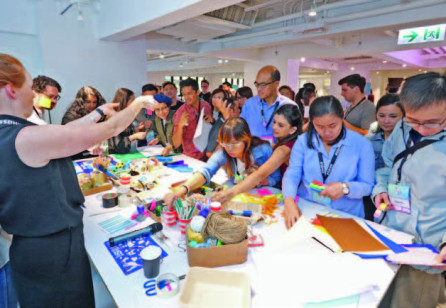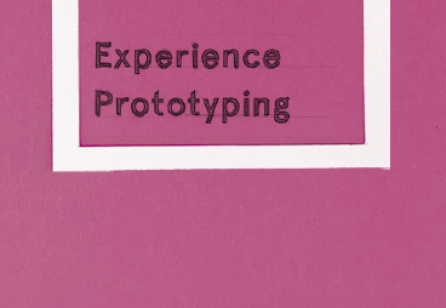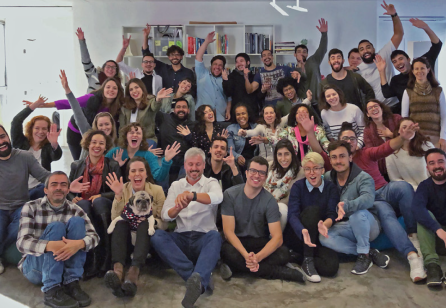Improving the quality is one domain of SD, but very often it is about innovation. How strong is Japan in the innovation of services?
KS: This is an important point. If we talk about innovation or new ecosystem, Japanese business people are interested: ‘This is for me!’, they’ll think. If we conduct service design workshops outside the company, it works well, quick prototypes of ideas, they get the idea. Sometimes it involves the whole system of the department – and that is huge, especially in terms of communication costs – and what gives the incentive to come to the workshop? Workshops tend to take time, so we need to have more incentives: why spend three or more hours for that purpose? We need to be very concrete and precise!
So the culture is a lot about efficiency and return of investment? ‘What do I get out of it?’
KS: Right, right…!
And since service design is a very result-open process, you don’t know what you get in the end. That makes it very difficult to sell, not only in Japan by the way, but also in Japan. Matt, you, as a non-native, what do you think might make it more difficult in Japan to apply service design?
MF: To comment on what Saso-San just said: innovation in service might be an area where service design could be more successful because that is where you can create new ways of monetizing service. Using service design to improve service is tricky, because it is usually pretty good already and, again, in Japan, change comes very hard. In the US we love to amend our constitution but, in Japan, the constitution is pretty much the same as it was when it was borrowed in the eighteen-hundreds from Germany (laughter).
Yes, it is very hard, once a system is in place, to have it changed, especially when it is considered to be working well. I think it has a lot to do a lot with the history of the country; it has a lot to do with craftsmanship, the teacher-student relationships. There is a standard way of doing things and the teacher teaches the pupils and then it gets fixed and it’s not easy to change. However, if we talk about absolutely new innovation, for example when the Olympics come, there are a lot of great areas where service design can be used to create a new service that is not yet in existence.
By the way, for the London Olympics, they had a specific service design team that applied service design to the experience of the Olympic Games. So if you give me the telephone number of the right person to talk to in Japan I would be happy to sell … (laughter … KS: I can give you one…) but my impression was also that in Japanese culture there is a great need for control and a great need for knowing how to do things, and my experience with service design is that it has tools but no rules!
KS: I am always fighting, trying to make it loose and more flexible, but people ask me what is the process, what is the next output? So I try to clarify the process first and then I try to be flexible as much as possible… that’s the only way. But still there is a lot of pressure, especially from the management people, who try to clarify the process as much as possible.
Matt, where do you see the difference between UX and service design?
MF: I think there is no difference. What I am creating is a touchpoint that is part of the service. And the people sitting next to me are maybe industrial designers and they are creating just another touchpoint as part of the service.
Our [Matt and Kentaro] business cards declare that we are service designers, but there is no such thing as a service designer: we are all service designers, we contribute, as you say, it is a collaborative cooperation.
That is an interesting point. You know my definition of service design is that we choreograph technologies, processes and people in order to create and co-create value for different stakeholders. So I do believe that service design is different because it has to be able to choreograph material evidence like products and digital evidence like interfaces and interactive evidence like people to people interaction and, in that way, I would probably claim that it is different, even though I agree that, in specific aspects, everybody is creating a part of the service system.
MF: And everyone should have that mindset. That they are creating, first and foremost, a service and that their individual responsibilities are to create the tangible touchpoints and, yes, it is a dance, but I am not sure who the choreographer is: is it one person who says I am the choreographer, I am the service designer? However, two years ago, at the service design conference in Japan, I gave a presentation on what I consider to be service design that I worked on here at Sony and it was an example of service design that really did not work too well. But there is an example at Sony: it comes from a video camera from the 80′s. There was a concept behind that camera: they were not just making hardware, they were making a broader experience of going out in the world and recording what you see. And that was expressed in the marketing: the whole point was that the whole video system was no bigger than your passport and you would go out into the world and discover new things and take the camera with you as a touchpoint to this bigger experience.
In line with the story, the instruction manual would use the same paper as a passport and, if you looked at the first page you read: “You are now about to embark on a journey and here is a checklist of what you might need… did you bring your socks…and, by the way, don’t forget to charge the camera and this is how you do it!” An instruction manual, but all encased in a very coherent story. And this was when communication design, marketing, interface design, they all were working together and, at that time, there was a person, the merchandiser, and, when I look back, it may be that that person, the merchandiser, was really the forerunner of service design.
I would still challenge that, because that is very much a marketing approach to storytelling. I would probably zoom out and ask ‘Where is the service experience?’ When you need to store the videos and the capacity of your card is full, where is the service when there is an incident and you lose it on your journey? So my challenge would be to go beyond the marketing and the storytelling to a more substantial service concept, an experience of being taken care of as a customer. But that is another story.
I would like to ask one last question: if you hire a service designer, what do you expect that they bring to the team?
KH: A person who has working experience. It is important. Graduating from the University and coming directly to the company… they don’t see the problems that the company has with the real business. We need to have some experiences.
KS: First, obviously, design research experience, getting the insight from it and also the facilitation skill to involve several functions: two critical points.
MF: I am thinking more along the line of a major design firm: one of their job requirements is to be good presenters and to be very passionate, especially at a place like Sony, which is very manufacture-and-technology oriented. That passion is going to get the story across.
I would like to add courage, because, in such a big organisation, it takes courage to break the rules instead of obeying them. Thank you very much for your time. It was very interesting and insightful for me personally and, I trust, for our readers, too!
Find more about Sony Design on their website!











Share your thoughts
0 RepliesPlease login to comment